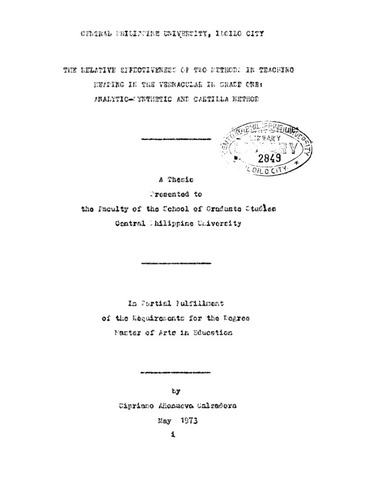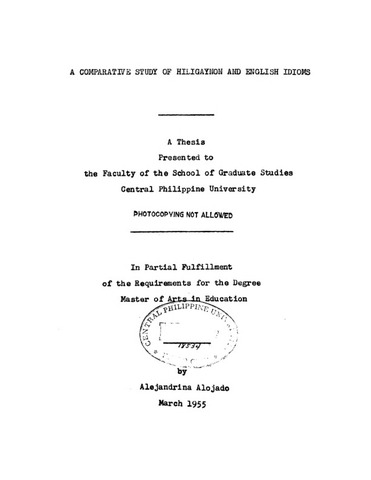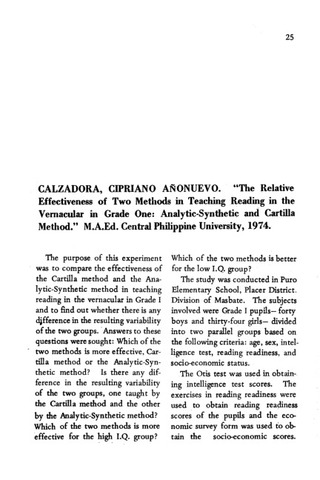The relative effectiveness of two methods in teaching reading in the vernacular in grade one: Analytic-synthetic and Cartilla method
| dc.contributor.author | Calzadora, Cipriano Añonuevo | |
| dc.date.accessioned | 2021-10-01T07:21:17Z | |
| dc.date.available | 2021-10-01T07:21:17Z | |
| dc.date.issued | 1973 | |
| dc.identifier.citation | Calzadora, C. A. (1973). The relative effectiveness of two methods in teaching reading in the vernacular in grade one: Analytic-synthetic and Cartilla method (Unpublished Master’s thesis). Central Philippine University, Jaro, Iloilo City. | en_US |
| dc.identifier.uri | https://hdl.handle.net/20.500.12852/1463 | |
| dc.description | Abstract only | en_US |
| dc.description.abstract | The purpose of this experiment was to compare the effectiveness of the Cartilla method and the Analytical- Synthetic method in teaching reading in the vernacular in grade I and to find out whether there is any difference in the resulting variability of the two groups. Answers to these questions were sought: which of the two methods is more effective, Cartilla method or the Analytical-Synthetic method? Is there any difference in the resulting variability of the two groups, one taught by the Cartilla method and the other by the Alytic-Synthetic method? Which of the two methods is more effective for the high I.Q. group? The study was conducted in Puro Elementary School, Placer District, Division of Masbate. The subjects involved were Grade I pupils--forty boys and thirty-four girls--divided into two parallel groups based on the following criteria, age, sex, intelligence test, reading readiness, and socio-economic status. The Otis test was used in obtaining intelligence test scores. The exercises in reading readiness were used to obtain reading readiness scores of the pupils and the economic survey form was used to obtain the socio-economic scores. These three testing instruments were borrowed from the Central Philippine University Research Center. The means and the standard deviation of scores on these three factors were computed to determine the T-scores of the pupils in each test. The T-scores of the pupils in the intelligence test, reading readiness, and socio-economic were added in order to derive the composition scores. Two boys with the ages of seven or eight and whose composite scores are the same or nearly the same were paired. The same procedure was followed for the girls. In order to test the equatedness of the two groups in the factors previously mentioned, the difference between the means of composite scores of two groups was tested for significance with the use of the t-ratio. The difference between the standard deviations of the two groups was computed in order to determine whether they were equated in variability. Both findings showed that the obtained difference between two standard deviations was insignificant at the 5 per cent level. The means and the standard deviations of Group A and Group B in the I.Q., reading readiness, and socio-economic are almost identical, showing the original pairing of scores to have been quite satisfactory. The two methods used in the study were the Analytic- Synthetic method and the Cartilla method. Method I, the Analytic-Synthetic method was used in Group A and Method II, the Cartilla method was used in Group B. The daily subject matter was made comparable as much as possible. The same teacher-- the investigator-- taught reading in both classes. The procedures as prescribed in the outline of work on both methods were strictly followed. There were two teacher-made tests given to the pupils within the six months of the experiment. The first test was given primarily to familiarize the pupils with printed tests and acquaint them with printed letters, words, phrases, and even long sentences before taking the final test. The achievement test was given to determine the effect of the two methods. The means and the standard deviations were statistically treated. The mean difference be- tween the two groups was tested for significance with the use of the t-ratio. The difference between the standard deviations or two groups was also tested for significance in order to determine the variability of the two groups. At the close of the experiment, it was found out that: 1. The difference between the means between Group A and Group B was insignificant at the .05 level. 2. The difference between the standard deviations was also insignificance at the 54 per cent level. 3. The difference between the means between Group A and Group B with high scores in the I.Q. test was not significant at the 5 per cent level. 4. The difference between the means between the two groups with low scores in the I.Q. test was not also significant at the .05 level. The following conclusions on the basis of the above results yielded by the two methods used in the study are: 1. Neither of the two methods is better than the other for the teaching of reading in the vernacular in Grade I and neither of the two methods is better than the other for teaching of reading to Grade I pupils with high scores in the I.Q. test nor to the Grade I pupils with low scores in the I.Q. test. 2. The difference in variability of the two groups was not affected with the method used. Since the results of the investigation revealed that neither of the two methods is more effective than the other, it is recommended that: 1. The grade I teachers be given the option as to which method to use in the class. The selection of the two methods will depend upon the availability of the needed materials and the cost of labor incurred in preparing them. 2. A replication of the research be done in the central school where the environment and family background of the pupils involved are quite different from those in the barrio. It could be of some use to education and to Grade I teacher if research be done on this problem: (1.) what are the teachers', parents', and pupils' attitude towards the method used in teaching reading? | en_US |
| dc.format.extent | xv, 170 leaves | en_US |
| dc.language.iso | en | en_US |
| dc.subject.ddc | GSL Theses 378.242 C139 | en_US |
| dc.subject.lcsh | Reading (Elementary) | en_US |
| dc.subject.lcsh | Reading (Elementary)--Ability testing | en_US |
| dc.subject.lcsh | Teaching--Methodology | en_US |
| dc.subject.lcsh | Language and languages--Study and teaching--Methodology | en_US |
| dc.subject.lcsh | Hiligaynon language | en_US |
| dc.subject.lcsh | Native language | en_US |
| dc.subject.lcsh | Native language--Study and teaching (Elementary) | en_US |
| dc.subject.lcsh | Hiligaynon language--Study and teaching (Elementary) | en_US |
| dc.title | The relative effectiveness of two methods in teaching reading in the vernacular in grade one: Analytic-synthetic and Cartilla method | en_US |
| dc.type | Technical Report | en_US |
| dc.description.bibliographicalreferences | Includes bibliographical references | en_US |
| local.relation.associatedcontent | https://repository.cpu.edu.ph/handle/20.500.12852/2137 Journal article published in Southeast Asia Journal | en |





